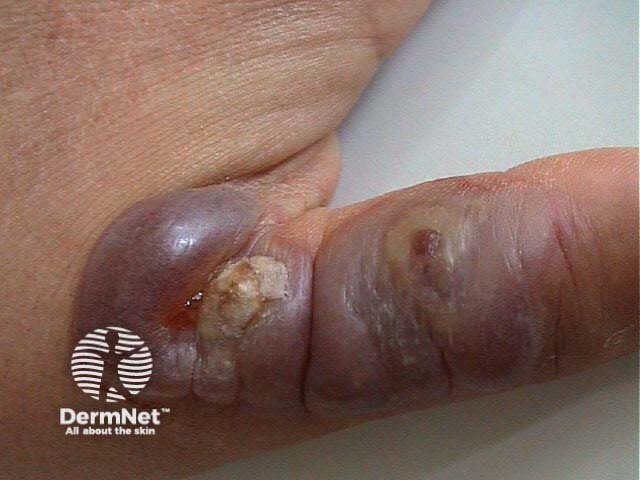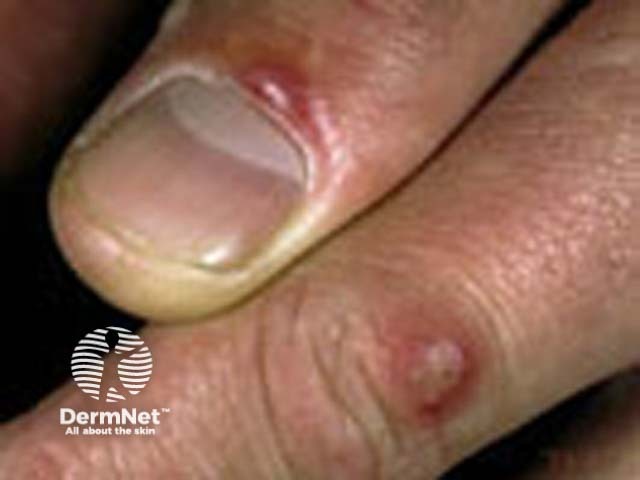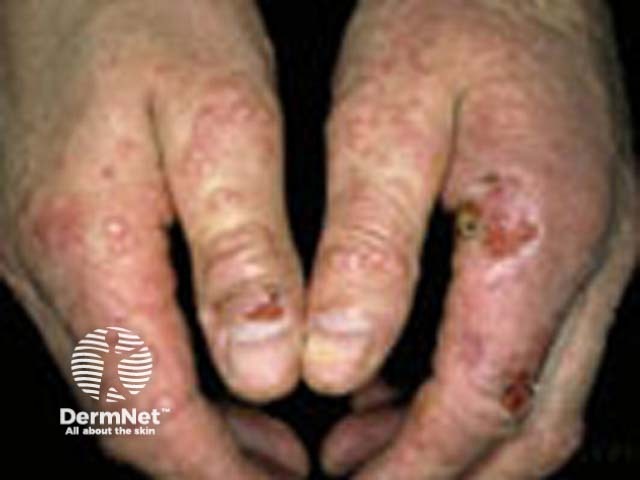Main menu
Common skin conditions

NEWS
Join DermNet PRO
Read more
Quick links
Orf and milkers' nodules
Created 2009.
Learning objectives
- Identify and manage parapox virus infections
Introduction
Parapox virus infections include orf and milkers' nodules and arise mainly in farmers or meat industry workers. They cause distinctive localised skin infections and resolve spontaneously without specific treatment.
The virus is a cylindrical double-stranded DNA virus and can be identified on electron microscopy.
Orf
Orf affects young lambs and goats who contract the infection from one another or possibly from persistence of the virus in the pastures and on fences etc. Human lesions are caused by direct inoculation of infected material.
The incubation period is about a week. Orf lesions are generally solitary or few in number. They occur most commonly on the fingers, hands or forearms but can appear on the face. The initial lesion is an irritable firm, red or reddish-blue papule that enlarges to form a flat-topped, blood-tinged blister within a nodule. The fully developed lesion is usually 2 or 3 cm in diameter but may be as large as 5 cm. A central crust appears and the lesion begins to shrink, disappearing without scarring within 4 to 6 weeks.
Orf Orf 

There may be a mild fever, malaise, lymphangiitis and localised lymphadenopathy.
Orf may be complicated by:
- Scattered widespread blisters at height of infection
- Toxic erythema 10-14 days after the onset
- Erythema multiforme
- Rarely, bullous pemphigoid
Orf recovers spontaneously in 3 to 6 weeks. No specific treatment is necessary in most cases. The lesion may be covered to prevent contaminating the environment or other people, although person-to person spread is very uncommon. Any secondary bacterial infection should be treated. Large lesions can be removed by shave excision.
Milkers' nodule
Milkers' nodule is an infection of the skin caused by a virus that infects the teats of cows. It is sometimes called cowpock although it is important to note this is a different condition from cowpox (in recent reports from Europe, cowpox has been acquired from cats and small rodents rather than cows).
Milkers' nodule is caused by a parapox virus. It produces mild infections of the teats of cows, i.e. ring sores, as well as ulcers in the mouths of calves. It is similar to bovine papular stomatitis virus, which affects the same sites in cattle. The two viruses are variants. Both can produce lesions on the hands of dairy farmers or vets who examine the mouths of animals. Human infection is from contact with infected lesions on the animals. Human-to-human spread appears not to have been recorded.
After an incubation period of 5-14 days small, red, raised, flat-topped papules develop. Within a week they appear as red-blue, firm, slightly tender nodules, usually between 2 and 5 in number although they may be solitary or more numerous. The nodules are usually on the hands, particularly the fingers, but occasionally the face. The top of the nodules often develops a greyish skin and a small crust. There maybe secondary bacterial infection, lymphangitis and regional lymphadenopathy.
Milkers nodule Milkers nodule Milkers nodule 


©R Suhonen
Milkers' nodules usually resolve spontaneously, without scarring, in 4-6 weeks. They should be covered to prevent contamination of the environment and also potentially spread to other people. Gloves should be worn if milking. Any secondary bacterial infection should be treated.
Activity
What other animals may be infected by parapox viruses?
On DermNet
Information for patients
Other websites
- Medscape Reference:
- Merck Manual Professional: Zoonotic Diseases (viral)
